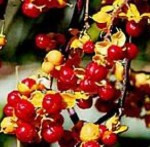 A fall visit to our nursery in New Jersey is always a treat, offering an opportunity to collect an abundance of greens, cones, twigs, and other items for the holidays. American bittersweet grows there with abandon and I can help myself to all I can carry home. Of course, the head gardener is not nearly so enthusiastic about the abundance of American bittersweet since it grows over many valuable shrubs and trees with a tenacity and strength that leaves them in no condition to sell. The vigorous vines can grow 20’ in a single season and climb by twining, girdling the stems of shrubs and trees if left unchecked. When used alone or combined with shrubs the vines can provide erosion control and ground cover for wildlife but also can easily be trained to climb on walls, trellis and fences. The bright orange-red berry-like fruit produced in October provide food for wildlife and are perfect for fall arrangements. Male and female flowers are produced on different plants so planting at least three plants close together is necessary to ensure the production of berries. The leaves are glossy green in summer and turn yellow before falling in autumn. A related species, Oriental bittersweet (C. orbiculatus), is very invasive and should be assiduously avoided.
A fall visit to our nursery in New Jersey is always a treat, offering an opportunity to collect an abundance of greens, cones, twigs, and other items for the holidays. American bittersweet grows there with abandon and I can help myself to all I can carry home. Of course, the head gardener is not nearly so enthusiastic about the abundance of American bittersweet since it grows over many valuable shrubs and trees with a tenacity and strength that leaves them in no condition to sell. The vigorous vines can grow 20’ in a single season and climb by twining, girdling the stems of shrubs and trees if left unchecked. When used alone or combined with shrubs the vines can provide erosion control and ground cover for wildlife but also can easily be trained to climb on walls, trellis and fences. The bright orange-red berry-like fruit produced in October provide food for wildlife and are perfect for fall arrangements. Male and female flowers are produced on different plants so planting at least three plants close together is necessary to ensure the production of berries. The leaves are glossy green in summer and turn yellow before falling in autumn. A related species, Oriental bittersweet (C. orbiculatus), is very invasive and should be assiduously avoided.
Type: Perennial vine.
Bloom: Small yellow flowers in May-June.
Size: 3′-20′ long.
Light: Full sun to light shade.
Soil: Average, moist to dry, well drained.
Hardiness: Zones 3-8.
Care: Prune to keep vine from strangling shrubs and trees.
Pests and Diseases: None of importance.
Propagation: Seeds, cuttings.
Outstanding Selection: Autumn Revolution (Celastrus scandens ‘Bailumn’) has both sexes on the same vine so only one needs to be planted for fruit production. The amount of berries, however, may not be as great as that of the species.
